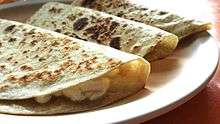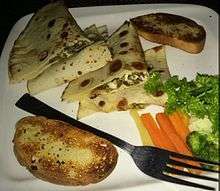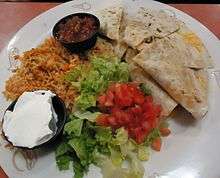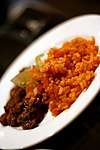Quesadilla
A quesadilla (/ˌkeɪsəˈdiːjə/; Spanish: [kesaˈðiʝa] (![]()
 Three quesadilla halves | |
| Type | Sandwich |
|---|---|
| Place of origin | Mexico |
| Region or state | National |
| Serving temperature | Hot |
| Main ingredients | Tortillas, cheese, meat, salsa, refried beans, avocado |
| 528 kcal (2211 kJ) | |


A full quesadilla is made with two tortillas that hold a layer of cheese between them. A half is a single tortilla that has been filled with cheese and folded into a half-moon shape.[1][2] A quick version of the quesadilla, the cheese tortilla, is microwaved and often served to children.[3]
History
The quesadilla has its origins in colonial Mexico. The quesadilla as a food has changed and evolved over many years as people experimented with different variations of it.[4] Quesadillas are frequently sold at Mexican restaurants all over the world.
Types
Original Mexican quesadilla
In the central and southern regions of Mexico, a quesadilla is a flat circle of cooked corn masa, called a tortilla, warmed to soften it enough to be folded in half, and then filled. They are typically filled with Oaxaca cheese (queso Oaxaca), a stringy Mexican cheese made by the pasta filata (stretched-curd) method. The quesadilla is then cooked on a comal until the cheese has completely melted. They are usually cooked without the addition of any oil. Often the quesadillas are served with green or red salsa, chopped onion, and guacamole.[5] While Oaxaca (or string) cheese is the most common filling, other ingredients are also used in addition to, or even substituting for, the cheese. These can include cooked vegetables, such as potatoes with chorizo, squash blossoms, mushrooms, epazote, huitlacoche, and different types of cooked meat, such as chicharron, tinga made of chicken or beef, or cooked pork. In some places, quesadillas are also topped with other ingredients, in addition to the fillings they already have. Avocado or guacamole, chopped onion, tomato, serrano chiles, and cilantro are the most common. Salsas may also be added as a topping.[6]

Mexican quesadillas are traditionally cooked on a comal, which is also used to prepare tortillas. As a variation, the quesadillas can be fried in oil to make quesadillas fritas. The main difference is that, while the traditional ones are prepared by filling the partially cooked tortillas, then cooked until the cheese melts, the fried ones are prepared like a pastry, preparing the uncooked masa in small circles, then topping with the filling and finally folding the quesadilla to form the pastry. It is then immersed into hot oil until the exterior looks golden and crispy.[7]
Other variations include the use of wheat flour tortillas instead, especially in Northern Mexico. Wheat dough is most commonly used in place of corn masa. In this case, the flour tortilla is prepared, folded and filled with cheese (mainly Chihuahua cheese or queso mennonita [a local cheese made by the mennonites.] Which the way of preparation is exactly the same as the corn variety.[8]
Sometimes, cheese and ham are sandwiched between two flour tortillas, then cut into wedges to serve what is commonly known as sincronizada (Spanish for "synchronized") in Mexico. Despite appearing almost the same as a quesadilla, it is considered a completely different dish. Tourists frequently confuse the sincronizada with the quesadilla because it is typically called a quesadilla in most Mexican restaurants outside of Mexico.[9][10]
U.S. quesadilla

The quesadilla is a regional favorite in the southwestern U.S. where it is similar to a grilled cheese sandwich, with the inclusion of local ingredients. A flour tortilla is heated on a griddle, then flipped and sprinkled with a grated, usually high-moisture, melting cheese (queso quesadilla), such as Monterey Jack, Cheddar cheese, or Colby Jack. Once the cheese melts, other ingredients, such as shredded meat, peppers, onions, or guacamole may be added, and it is then folded and served.[11]
Another preparation involves cheese and other ingredients sandwiched between two flour tortillas, with the whole package grilled on an oiled griddle and flipped so both sides are cooked and the cheese is melted.[12] This version is often cut into wedges to serve. A home appliance (quesadilla maker) is sold to produce this kind of quesadilla, although it does not use oil and cooks both sides at once. This type is similar to the Mexican sincronizada; but in the United States, they often also have fajita beef or chicken or other ingredients instead of ham. That kind of quesadilla is also Mexican, and it is called "gringa" (the name varies in some regions in Mexico, including a type of quesadilla called "chavindeca").
Regional variations to specific recipes exist throughout the Southwest.
Variations
Quesadillas have been adapted to many different styles. In the United States, many restaurants serve them as appetizers, after adding their own twist.[13] Some variations use goat cheese, black beans, spinach, zucchini, or tofu.[14] A variation that combines the ingredients and cooking technique of a quesadilla with pizza toppings has been described as a "pizzadilla".[15][16]
Even dessert quesadillas are made, using ingredients such as chocolate, butterscotch, caramel and different fruits.[17]
See also
- List of maize dishes
- List of Mexican dishes
References
- Herbst, Sharon Tyler (2001). Food Lover's Companion (Third ed.). Barron's Educational Series. p. 501. ISBN 0-7641-1258-9. OCLC 43894522.
- "Photo". gannett-cdn.com.
- "Kids' Recipe: Cheese Tortilla". WebMD. Retrieved August 8, 2018.
- Kiple, Kenneth F. & Ornelas, Kriemhild Coneè (2000). The Cambridge World History of Food. 2 vols. New York: Cambridge University Press. ISBN 9780521402163. OCLC 44541840.
- "History of Quesadillas". cookingschoolsite (blog). Retrieved February 27, 2012 – via Google Sites.
- Montanari, Massimo (1994). The Culture of Food. Oxford, UK: Blackwell. ISBN 9780631182658. OCLC 29024700.
- Elkady, Doaa (2008). "Quesadillas". Scholastic Choices. 23 (5). p. 23.
- Feeney, Kelly (May 28, 2010). "Sand, Surf, and Quesadillas". The New York Times. p. 8.
- Raichlen, Steven (1998). Salud y sazón: 200 deliciosas recetas de la cocina de mamá : todas bajas en grasa, sal y colesterol! [Health and season: 200 delicious recipes from the kitchen of mom, all low in fat, salt and cholesterol!] (in Spanish). Rodale. p. 246. ISBN 978-0-87596-474-4. OCLC 39033466. Retrieved March 18, 2011.
- Raichlen, Steven (2000). Steven Raichlen's Healthy Latin Cooking: 200 Sizzling Recipes from Mexico, Cuba, Caribbean, Brazil, and Beyond. Rodale. ISBN 9780875964980. OCLC 39033464.
- SR. "Recipe - Delicious Chicken Quesadilla". Cooks.com. Retrieved February 27, 2012.
- Zaslavsky, Nancy (2006). "30 Minutes". Vegetatrian Times. 338. pp. 37–40.
- Shulman, Martha Rose (2011). "Black Bean and Goat Cheese Quesadilla". The New York Times. p. 1.
- Shulman, Martha Rose (2011). "Spinach and Goat Cheese Quesadilla". The New York Times. p. 1.
- "BBC Good Food - Pizzadilla". BBC Good Food. 2012. Retrieved August 26, 2019.
- Zhou, Naaman (August 26, 2019). "What is this chicken-stuffed deep-fried pizzadilla business, and why is it all over Twitter?". The Guardian. Retrieved August 26, 2019.
- DeWan, James P. (May 10, 2016). "How to put anything you can think of into a quesadilla". Chicago Tribune. Retrieved October 14, 2019.
Further reading
- Gay, Kathlyn (1996). Encyclopedia of North American Eating and Drinking Traditions, Customs, and Rituals. Santa Barbara, CA: ABC-CLIO. ISBN 9780874367560.
External links
| Wikimedia Commons has media related to Quesadilla. |


.jpg)

